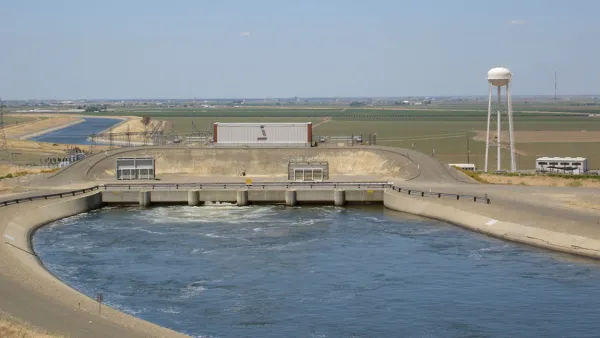Theft by illegal marijuana grow operations is straining California's already dwindling water supplies and endangering local communities as authorities lock hydrants and restrict access to water sources.

"As drought grips most of California, water thievery across the state has increased to record levels," writes Julie Cart, straining resources and causing concern in small communities dependent on scarce supplies.
Bandits in water trucks are backing up to rivers and lakes and pumping free water they sell on a burgeoning black market. Others, under cover of darkness, plug into city hydrants and top up. Thieves also steal water from homes, farms and private wells, and some even created an elaborate system of dams, reservoirs and pipelines during the last drought. Others are MacGyvering break-ins directly into pressurized water mains, a dangerous and destructive approach known as hot-tapping.
Northern California faces a similar problem as water theft has started to deplete the Russian River and other important waterways. "In one water district there, thefts from hydrants could compromise a limited water supply for fighting fires, which is why they have put locks on hydrants."
"No cache of water is safe. During the last major drought, businesses, schools and even a fire station were victims of water theft. In 2014, thieves pumped water from storage tanks belonging to the North San Juan Fire Protection District in Nevada County, in the mountains northeast of Sacramento." In the Sierra Nevada, Nevada County estimates that it is home to close to 4,000 illegal operations, while "[i]n the Antelope Valley, illegal grows have doubled from 200 last year to 400 today, according to county data, while other estimates put the number in the thousands."
While marijuana uses about the same amount of water as a tomato plant, all told, the illegal operations use around 5.4 million gallons per day, straining California's already limited supply as authorities struggle to understand and address the problem. "The state Water Resources Board, which has a modest cadre of 80 investigators who track water diversion and theft from California’s rivers and streams, cannot begin to keep up with the epidemic of stolen water. Nor is the agency’s $1,000 a day fine for water theft proving to be an effective deterrent to offset the rewards for a multi-billion dollar criminal industry." Recently, "the Los Angeles County Board of Supervisors, fed up with water theft and their lack of authority to address it, passed a resolution to petition state legislators to give them power to prosecute water theft, especially during severe droughts."
California can learn from Australia's experience with a similar issue. On the arid island nation, authorities created a powerful new agency to stem the illegal siphoning of water. The agency includes "a large enforcement team backed by fines and the threat of revocation of water licenses" and uses "satellite images, drones, remote-controlled watercraft and software that compares what’s growing on farms with their legal water allocation." As droughts intensify and water becomes more scarce, California must take steps to enhance its own enforcement and protect this vital resource.
FULL STORY: Thieves are stealing California’s scarce water. Where’s it going? Illegal marijuana farms

Analysis: Cybertruck Fatality Rate Far Exceeds That of Ford Pinto
The Tesla Cybertruck was recalled seven times last year.

National Parks Layoffs Will Cause Communities to Lose Billions
Thousands of essential park workers were laid off this week, just before the busy spring break season.

Retro-silient?: America’s First “Eco-burb,” The Woodlands Turns 50
A master-planned community north of Houston offers lessons on green infrastructure and resilient design, but falls short of its founder’s lofty affordability and walkability goals.

Test News Post 1
This is a summary

Analysis: Cybertruck Fatality Rate Far Exceeds That of Ford Pinto
The Tesla Cybertruck was recalled seven times last year.

Test News Headline 46
Test for the image on the front page.
Urban Design for Planners 1: Software Tools
This six-course series explores essential urban design concepts using open source software and equips planners with the tools they need to participate fully in the urban design process.
Planning for Universal Design
Learn the tools for implementing Universal Design in planning regulations.
EMC Planning Group, Inc.
Planetizen
Planetizen
Mpact (formerly Rail~Volution)
Great Falls Development Authority, Inc.
HUDs Office of Policy Development and Research
NYU Wagner Graduate School of Public Service




























